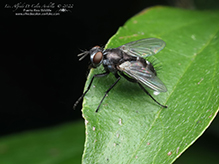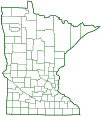Tachinid flies
(Admontia spp.)
Overview • Description • Distribution • Taxonomy

Overview
Admontia is a genus of parasitic flies in the family Tachinidae. It occurs in Europe and North America. There are 38 Admontia species worldwide, 12 species in North America north of Mexico, and at least 1 species in Minnesota.
Admontia larvae are parasitic on the larvae of crane flies (family Tipulidae), and there are records of one species Admontia degeerioides parasitizing two species of moth larvae.
Description
The following characters differentiate the genus Admontia from other genera in the tribe Blondeliini.
The eyes are bare. On males, the bristles along the inner margin of the compound eyes (orbital bristles) are bent or pointed forward. On the side of the face there are hairs at least on the upper third. There are bristles on more than half of the ridge that runs down the center of the face (facial ridge). The cheeks (genae) are very broad. The antennae have three segments. The third segment has a large bristle (arista) on the upper surface. The arista is thickened at least on the lower half.
The thorax is large and it has three segments. Each segment has four principal exoskeletal plates, one above, one below, and one on each side. The upper (dorsal) plates, from front to rear, are the prescutum, scutum, and scutellum. The scutum is large and rounded. On each side of the scutum, in the shoulder (humeral) area just behind the head, there is a small plate (postpronotum). The postpronotum has three bristles arranged in a triangle. The inner basal bristle is often weak, and it is sometimes absent.
On the front legs of the female, the last part of the leg (tarsus), corresponding to the foot, is swollen or flattened on most species.
Distribution |
||
|
Sources No records of Admontia in Minnesota can be found, but two species (one currently recognized species) is on the Cedar Creek Ecosystem Science Reserve Checklist of Minnesota Insects. |
|
| 9/30/2025 | ||
Taxonomy
Order
Suborder
Brachycera
Infraorder
Cyclorrhapha
Zoosection
Schizophora
Zoosubsection
Calyptratae (Calyptrate Flies)
Superfamily
Oestroidea (Bot Flies, Blow Flies, and Allies)
Family
Subfamily
Exoristinae
Tribe
Blondeliini
Subordinate Taxa
Admontia antarctica
Admontia aurata
Admontia badiceps
Admontia blanda
Admontia calyptrata
Admontia cepelaki
Admontia communis
Admontia continuans
Admontia debilis
Admontia degeerioides ![]()
![]()
Admontia delicatula
Admontia discalis
Admontia ducalis
Admontia duospinosa
Admontia finisterrae
Admontia flavibasis
Admontia gracilipes
Admontia longicornalis
Admontia longicornis
Admontia maculisquama
Admontia malayana
Admontia nasoni ![]()
Admontia nigrita
Admontia occidentalis
Admontia offella
Admontia pergandei ![]()
Admontia pictiventris
Admontia podomyia
Admontia pollinosa ![]()
Admontia pyrenaica
Admontia quwi
Admontia rufochaeta ![]() *
*
Admontia seria
Admontia stackelbergi
Admontia tarsalis
Admontia washingtonae
Admontia zimini
* Most sources treat Admontia rufochaeta as a synonym for Admontia nasoni.
Synonyms
Admontiopsis
Austrostaurochaeta
Euadmontia
Euhyperecteina
Gravenhorstia
Iconomedina
Poliops
Trichopareia
Trichoparia
Xenadmontia
Common Names
This genus has no common name. The common name for the family Tachinidae is tachinid flies, and it is applied here for convenience.
Glossary
Arista
A large bristle on the upper side of the third segment of the antenna of a fly. Plural: aristae.
Gena
In insects: The area between the compound eye and the mandible; the cheek. In birds: The area between the the angle of the jaw and the bill; the feathered side (outside) of the under mandible. Plural: genae.
Visitor Photos
Share your photo of this insect.
This button not working for you?
Simply email us at info@MinnesotaSeasons.com.
Attach one or more photos and, if you like, a caption.
Alfredo Colon |
 |
MinnesotaSeasons.com Photos
|

Slideshows

Visitor Videos
Share your video of this insect.
This button not working for you?
Simply email us at info@MinnesotaSeasons.com.
Attach a video, a YouTube link, or a cloud storage link.
Other Videos



